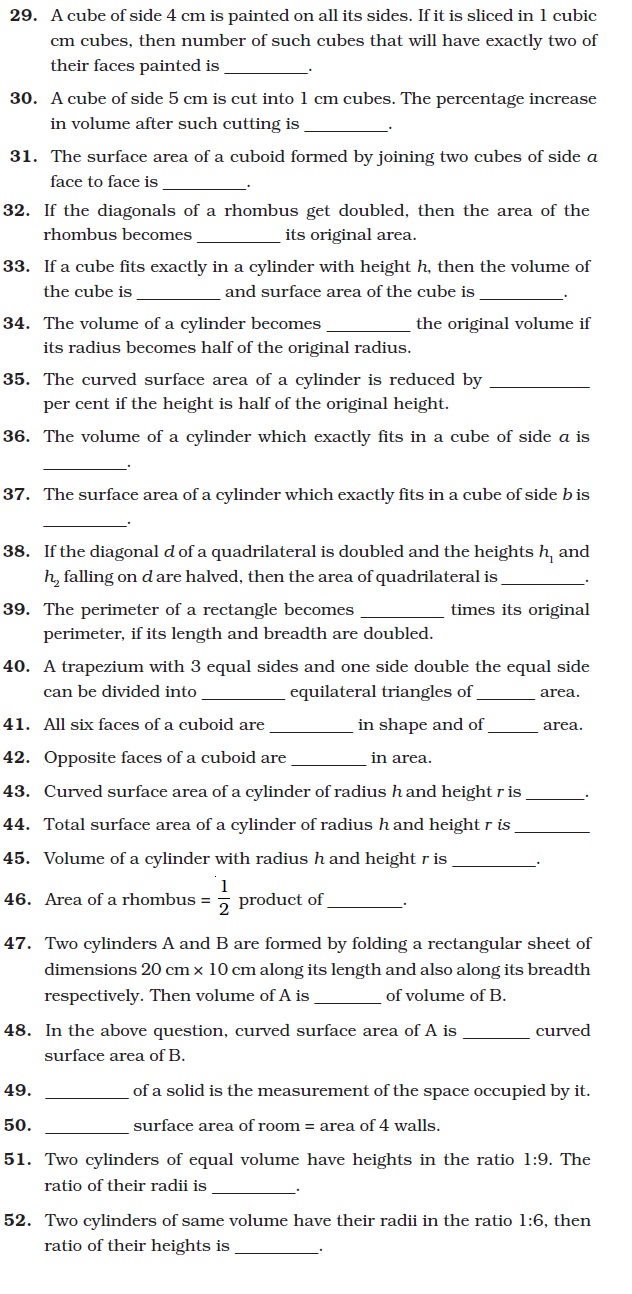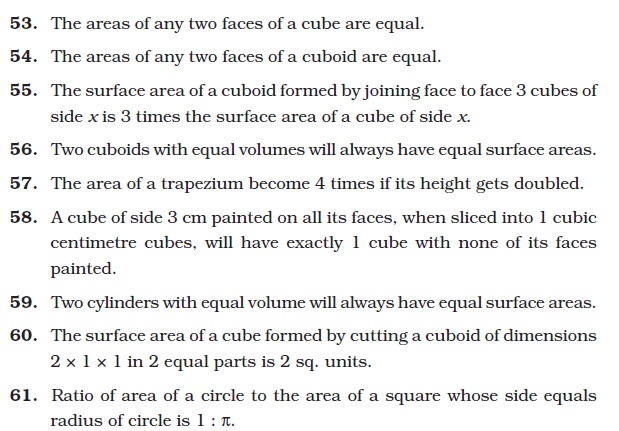Candidates can download NCERT Exemplar Class 8 Maths Unit 11 from this page. The exemplar has been provided by the National Council of Educational Research & Training (NCERT) and the candidates can check it from below for free of cost. It contains objective, very short answer type, short answer type, and long answer type questions. Along with it, the answer for each question has also been provided. From the NCERT Exemplar Class 8 Maths Unit 11, candidates can understand the level and type of questions that are asked in the exam.
NCERT Exemplar Class 8 Maths Unit 11 Mensuration
NCERT Class 8 Maths Unit 11 is for Mensuration. The type of questions that will be asked from NCERT Class 8 Maths Unit 11 are displayed in the below provided NCERT Exemplar Class 8 Maths Unit 11. With the help of it, candidates can prepare well for the examination.
Also Check: NCERT Solutions for Class 8 Maths
Main Concepts and Results
- Length of boundary of a simple closed figure is known as perimeter.
- Area is the measure of region enclosed in a simple closed curve.
- Perimeter of a rectangle = 2 (length + breadth).
- Area of a rectangle = length × breadth.
- Perimeter of a square = 4 × side.
- Area of a square = side × side
- Area of a triangle = 1 /2 × Base × Corresponding Height
- Area of a parallelogram = Base × Corresponding Height.
- Area of a circle = r² , where r is the radius.
- Area of a trapezium = 1 /2 × (Sum of parallel sides) × Height.
- Area of a rhombus = 1 /2 × Product of diagonals.
- Lateral surface area of a cube = 4 (side)².
- Total surface area of a cube = 6 (side)².
- Lateral surface area of a cuboid = 2 × height × (length + breadth).
- Total surface area of a cuboid = 2(lb + bh + hl).
- Lateral (curved) surface area of a cylinder = 2πrh.
- Total surface area of a cylinder = 2πr (r + h), where r is the radius and h is the height.
- Amount of space occupied by a solid is called its volume.
- Volume of a cube = (side)³.
- Volume of a cuboid = length × breadth × height.
- Volume of a cylinder = πr²h.
- 1cm³ = 1ml
- 1L = 1000 cm³.
- 1m³= 10,00,000 cm³ = 1,000 L.
Solved Examples
In examples 1 and 2, there are four options out of which one is correct.
Write the correct answer.

In examples 3 and 4, fill in the blanks to make the statements true.


In examples 5 and 6, state whether the statements are true (T) or false (F).





Vocabulary Connections







Think and Discuss
(a) What would be the cost of painting if cylindrical root is not to be painted?
(b) What would be the cost if one face is not included. Is there any difference in the cost?

Multiple Choice Questions

Fill in the Blanks Type Questions

True False Type Questions

Short Answer Type Questions

Applications, Games and Puzzles
1. Rashid has decided to build a swimming pool as shown in the figure on an empty plot 25 metres long and 15 metres wide. He is discussing with his son Majid about his plan to build the pool, put tiles on the bottom of the pool and other requirements of the pool. Can you help Majid to answer the following questions which his father has asked in the discussion?

1. What is the surface area of the pool?
2. If Rashid plans to cover the bottom and sides of the pool with square
tiles having side 25 cm, how many such tiles will be required?
3. If each tile costs Rs 40, how much will be the total cost?
4. A local digging company charges at the rate of Rs 150/- per cubic
metre. How much Rashid has to pay for digging the swimming pool?
[Hint : Volume = base area × height]
5. How long will it take for the swimming pool to be filled completely,
if a pipe is pouring water into the pool at the rate of 40 litres per
minute?
6. What is the area of the wall at the shallow end of the swimming
pool?
7. What is the area of the wall at the deep end of the swimming pool?
8. How much Rashid has to pay in total for making the swimming
pool operational, considering cost of digging the pool and fixing
tiles?
2. The following table shows the dimensions of cuboids such that,their volumes remain the same. Extend the table with as many more dimensions such that all the cuboids thus formed have the
same volume. Complete the table and write your conclusion on surface area and volume of each cuboid.

3. The figure shown is a geoboard in which a rectangle has been outlined using a rubberband.
1. What is the area of the rectangle?
2. Draw a similar figure whose area is 50% larger than this figure.
3. Draw a similar figure whose area is 25% larger than this figure.
4. Suppose that the figure shown is 75% of another figure. What would the other figure look like?

5. The enclosed area represents 75% of another area on the geoboard.
Use a geoboard or draw a diagram of a geoboard to represent 100%
of the area.

4.
i. Given here are sketches of front, back, sides and roof of a kennel. The drawings are as per the scale. 1 cm = 10 cm.


(ii) Sketches given above belong to which kennel?

(iii) Draw the net of the correct choice on the graph paper.
(iv) Take a waste piece of cardboard. Trace the net you have drawn above on the cardboard and fold it to make the kennel.
(v) If you had to pay Rs 2 for each square cm of surface area, how much would it cost you to paint the kennel?
5.
Word Maze

Find the names of the solids from the given word maze whose areas or volumes are given below by colouring the boxes using the given colour code.

Click here download the NCERT Exemplar Class 8 Maths Unit 11 Mensuration.
Answers to Multiple Choice Questions




To get study material, exam alerts and news, join our Whatsapp Channel.

